Working Without Distractions in Scrivener
By Gwen Hernandez | April 30, 2016 |
Need to keep your focus on your manuscript (and off your email, social media, and pop-up reminders to put on clothes)? Scrivener has a tool for that. It’s called Full Screen mode in Windows and Composition mode on the Mac.
I call it my Den of Zen, and it’s where I do most of my work. Nothing but my page of text and the background of my choice.
Entering Full Screen/Composition Mode
When you’re ready to block out everything and write, don a pair of noise-canceling headphones, hide your phone, and enter Full Screen/Composition mode (hereafter called FS/C for short).
- Mac: Go to View—>Enter Composition Mode.
- Windows: Go to View—>Enter Full Screen.
Or, click the appropriate button on the toolbar.
- Mac
- Win
By default, FS/C looks like this. Plain, but effective.
Making Changes with the Control Strip
Text too small? Paper too wide? When you first enter FS/C, or any time you point your mouse to the bottom of the screen, the control strip pops up.
It contains options for changing the text zoom, paper position, paper width, and background fade. It also displays the word and character count for the document(s) being viewed.
NOTE: Changes made here only affect the current project.
Changing the Background Color or Image for All Projects
Project-specific settings can be changed from the control strip, but global settings are available in the Scrivener Preferences/ Options menu.
1. Mac users go to Scrivener—>Preferences. Windows users go to Tools—>Options.
2. Choose Compose (Mac) or Appearance (Windows).
3. Mac users go to Customizable Colors at the bottom, and select Background. Windows users go to the Colors section, click the triangle next to Full Screen, then select Background.
4. To change the color, click the colored square and choose a new color.
Selecting a Background Image for a Single Project
Rather than color, I often opt to use a background image. Sometimes it’s just a picture that puts me in the mood to write, like a calming ocean scene, and sometimes it’s an image that keeps me in the setting of my story. For example, my book Blind Ambition was set largely on a fictional Caribbean island, so I used a photo from St. Lucia to keep me in a tropical frame of mind.
Background images are set at the project level, and will override the global color choice you made in the last section. Here’s how to add an image.
1. Make sure the image you want is accessible from a drive on your computer (e.g. hard drive, flash drive, Dropbox), or is imported into your current Scrivener project (i.e. in the Binder).
2. Go to View—>Composition Backdrop (Mac) or View—>Full Screen Backdrop (Windows).
3. If the image you want is saved within your project, choose it from the submenu. If not, click Choose and select the desired file from your computer.
4. Click Open.
Next time you enter FS/C mode, your background image is displayed.
Removing a Background Image
To remove the background image for a project, go to View—>Composition Backdrop—>No Backdrop (Mac) or View—>Full Screen Backdrop—>No Backdrop (Windows).
Viewing the Inspector from Full Screen/Composition Mode
If you really need to take a peek at your Inspector—maybe to review the synopsis, or to change a Label or Status value—there’s no need to leave FS/C mode.
Simply click the Inspector button in the control strip.
Mac users will see a modified version of the Inspector. Use the upper drop-down menu to choose which section of the Inspector you want to view.
Switching Documents in Full Screen/Composition Mode
One of my favorite features—especially when I’m deep in revisions—is the ability to jump to another document without ever leaving FS/C mode and breaking your flow.
Just click the Go To button in the control strip to choose another document.
My process: When I’ve finished edits on a document, I use the Inspector to change its Status so I know it’s done, then I use the Go To button to move to the next document that needs work.
Exiting Full Screen/Composition Mode
Sadly, at some point you’ll have to exit FS/C mode. Here are two ways.
- Press the ESC key on your keyboard.
- Pull up the control strip and click the Exit button at the far right.
Happy distraction-free writing!
What questions do you have for me about this or any other Scrivener feature? Fire away.
[coffee]


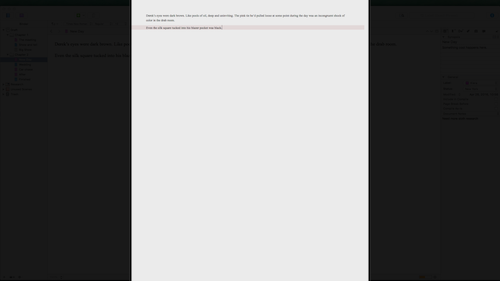
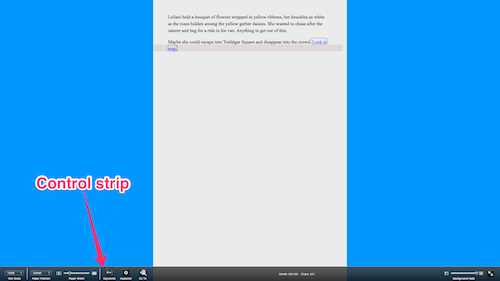
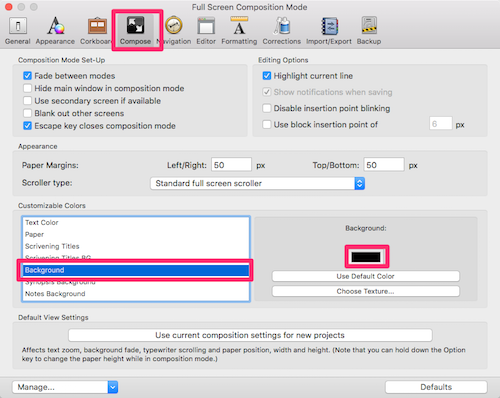
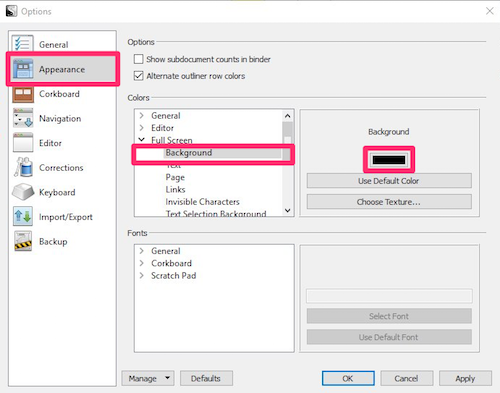
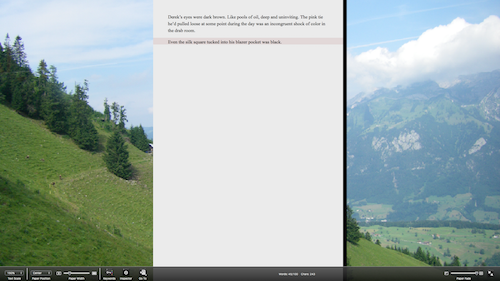
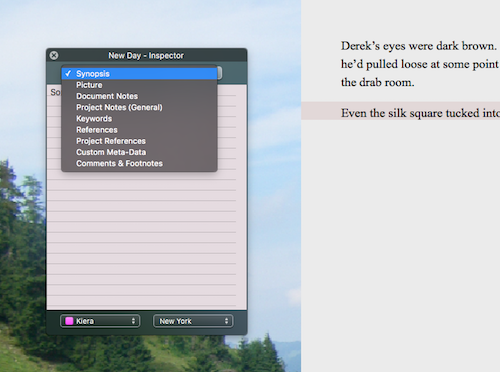
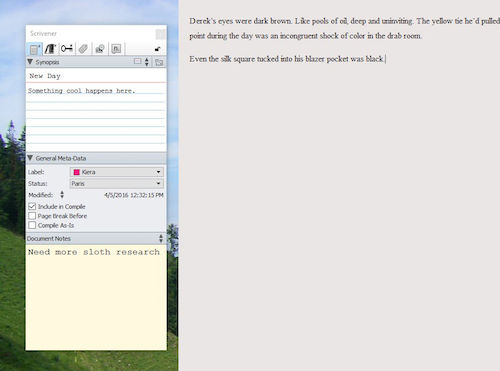








I love those tips. Scrivener has so much more depth than we realize when we first start using it. By the way, I see the IOS version is now in beta for nerds like me who have been waiting for years to use it on our iPads. It will be interesting to see if these features transfer over.
Thanks, Ron! I think discovering new Scrivener features is part of the fun. ;-)
Yes, the iOS version is in beta. So exciting! I’m one of the testers, and I think it looks pretty awesome. It can’t–by necessity have EVERYthing–but it seems to me like it has all the really important elements, and it’s fairly intuitive if you’re already an iPad or iPhone user.
I’ve written a summary post on Scrivener for iOS, what features we will get (officially confirmed) and when we can expect it to be released:
https://playingwriter.com/scrivener-for-ios-is-going-beta/
Thanks, Alex!
This is one of my favorite Scrivener features, Gwen. I often compose with the interior of my favorite deli, Langer’s, as the background. I took a picture of it for just this purpose. Then some ambient diner noise from Coffitivity, and it’s like I’m there. The only thing is after awhile I’m lusting for their #19 – hot pastrami on rye with swiss cheese, cole slaw, Russian dressing …
Me too, James. What a great way to get out of the house when you can’t get out of the house! Thanks for sharing your process. Hope you get your #19 soon. ;-)
Thanks, Gwen. The screenshots are especially helpful. So far I still find it a comfort to see the binder and inspector while I’m working in Scrivener, but I’m sure I’ll take advantage of this feature at some point.
Absolutely, Barbara! It’s all about having options. ;-)
It’s been over a year since anyone posted here but just wanted to chime in and say that I set up a new writing station strictly for writing (no cat videos or laser beam video games) and this is the first article I looked for and found. Great information. Keep it up.
That’s awesome, JDC. Eliminating distractions is half the battle. Good luck, and thanks for checking in! :-)